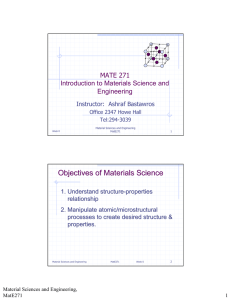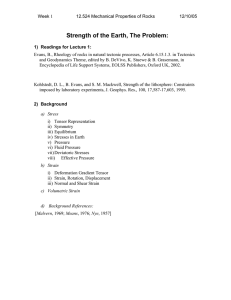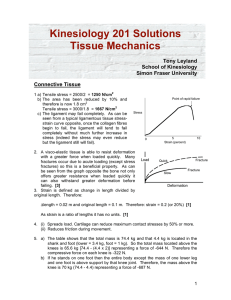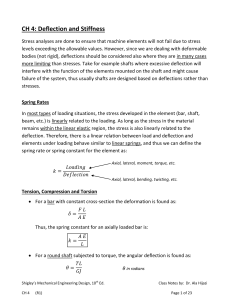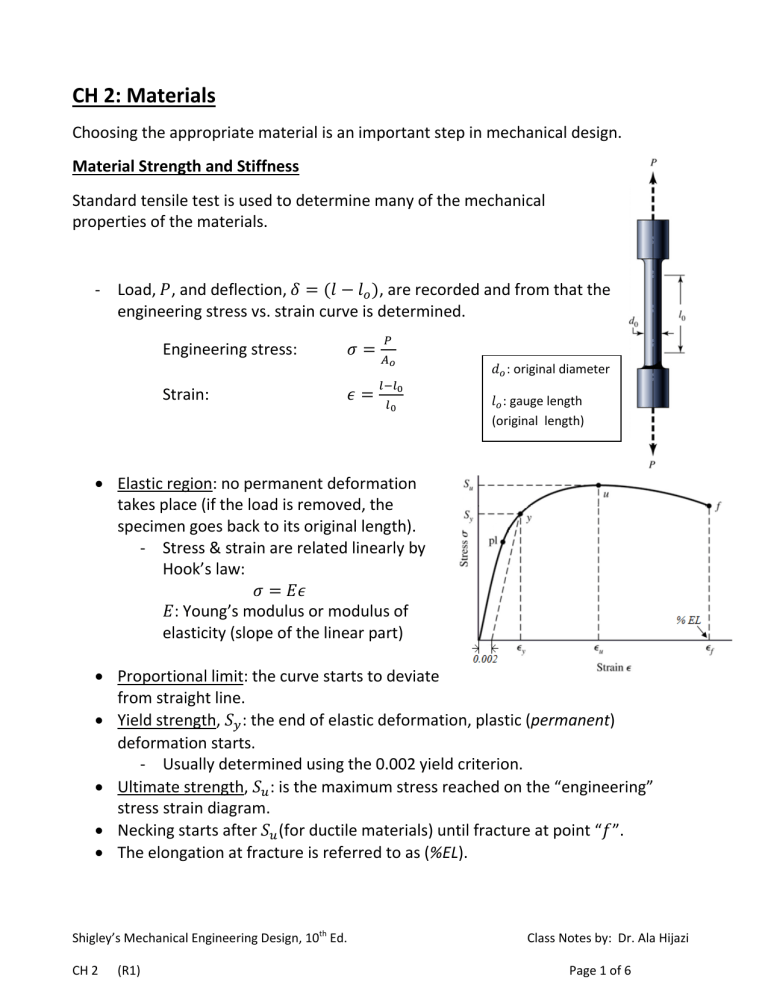
CH 2: Materials Choosing the appropriate material is an important step in mechanical design. Material Strength and Stiffness Standard tensile test is used to determine many of the mechanical properties of the materials. - Load, 𝑃, and deflection, 𝛿 = (𝑙 − 𝑙𝑜 ), are recorded and from that the engineering stress vs. strain curve is determined. Engineering stress: Strain: 𝜎= 𝜖= 𝑃 𝐴𝑜 𝑙−𝑙0 𝑙0 𝑑𝑜 : original diameter 𝑙𝑜 : gauge length (original length) Elastic region: no permanent deformation takes place (if the load is removed, the specimen goes back to its original length). - Stress & strain are related linearly by Hook’s law: 𝜎 = 𝐸𝜖 𝐸: Young’s modulus or modulus of elasticity (slope of the linear part) Proportional limit: the curve starts to deviate from straight line. Yield strength, 𝑆𝑦 : the end of elastic deformation, plastic (permanent) deformation starts. - Usually determined using the 0.002 yield criterion. Ultimate strength, 𝑆𝑢 : is the maximum stress reached on the “engineering” stress strain diagram. Necking starts after 𝑆𝑢 (for ductile materials) until fracture at point “𝑓”. The elongation at fracture is referred to as (%EL). Shigley’s Mechanical Engineering Design, 10th Ed. CH 2 (R1) Class Notes by: Dr. Ala Hijazi Page 1 of 6 Strength of a material usually refers to the yield strength. Stiffness refers to the amount of deformation the material shows under applied load. The lesser the deformation, the stiffer the material. - In the elastic region, “stiffness” refers to Young’s modulus. The higher the 𝐸, the higher the stiffness. Ductile and Brittle Materials Ductility measures the degree of plastic deformation sustained at fracture. A Ductile material is one that exhibits a large amount of plastic deformation before failure. - It shows necking before fracture. Example: Steels %EL > 20% A Brittle material exhibits little or no yielding before fracture. - Usually defined as materials having %EL < 5% at fracture. - It shows little or no necking before fracture. - It is much stronger in compression than in tension. Examples: gray cast iron & glass Table A-5 gives the physical constants for some materials. Table A-20 gives the mechanical properties for some steel alloys. Table A-24 gives the mechanical properties for some cast irons. Strength and Cold Work Cold working is a process in which the material is plastically deformed at a temperature below the recrystallization temperature (no creep occurs). - If a load was applied to the material such that the stress in the material exceeded the yield strength (but it is less than the ultimate strength) then the load was removed, the stress strain relationship during the unloading will follow a straight line parallel to the initial elastic line. Shigley’s Mechanical Engineering Design, 10th Ed. CH 2 (R1) Class Notes by: Dr. Ala Hijazi Page 2 of 6 - The material will have some amount of elastic recovery and some permanent deformation. Knowing that the unloading line have a slope of 𝐸, we can find the amount of elastic strain 𝜖𝑒 as, 𝜖𝑒 = 𝜎𝑖 𝐸 The total strain at point “𝑖” is: 𝜖 = 𝜖𝑝 + 𝜖𝑒 𝜖𝑝 : is the plastic (permanent) strain. - If the material was reloaded again, the stress strain relation will follow the same unloading line and point “𝑖” will be, approximately, the new yield point of the material. Heat Treatment of Steel Heat treatment refers to time & temperature-controlled process that relieves residual stresses and/or modifies material properties. Annealing When a material is cold (or hot) worked, residual stresses are introduced in the material. Also, the strength of the material is usually increased. Annealing is a heat treatment process in which the residual stresses are removed, the material is softened (strength is reduced) and the material is made to be more ductile. - The material to be annealed is heated to a temperature that is approximately 50˚C above the critical temperature and is held at this temperature for a sufficient time for the carbon to be dissolved and defused in the material. Then the object is allowed to cool-down slowly. Quenching Quenching is a process in which the material is hardened. - The material is heated to a temperature above the critical temperature then the material is cooled at a fast rate (using water or oil) to a temperature below the critical temperature. Shigley’s Mechanical Engineering Design, 10th Ed. CH 2 (R1) Class Notes by: Dr. Ala Hijazi Page 3 of 6 Tempering When a material is quenched, residual stresses are introduced because of the uneven fast cooling. Tempering is used to remove the residual stresses from the fully hardened material (which is very brittle) and it reduces hardness of the material. - After the material has been quenched, tempering is done by reheating the material to some temperature below the critical temperature for a certain period of time, then allowing it to cool in still air. Case Hardening The purpose of case hardening is to produce a hard outer surface on a specimen of low carbon steel while maintaining the ductility in the core. - Case hardening is usually done by increasing the carbon content at the surface by surrounding the surface by a carburizing material for a certain time at a certain temperature. Then the material is quenched down from this temperature and tempered. - Another method of case hardening is to heat the surface using a flame (or induction coil) then quenching and tempering. Table A-21 gives the mechanical properties for some heat-treated steels. (Q&T: Quenched and Tempered) Classification of Solid Materials Engineering materials fall into four major classes: Metals, Ceramics (including glasses), Polymers, and Composites. Metals Metals are combinations of metallic elements. They are strong and deformable, making them important materials in machine design. - Metals are good conductors of heat and electricity and not transparent to visible light. - Metals are usually ductile which helps in accommodating stress concentrations by deforming plastically such that loads are redistributed more evenly. - Metals can be made stronger by alloying and by mechanical and heat treatment. Shigley’s Mechanical Engineering Design, 10th Ed. CH 2 (R1) Class Notes by: Dr. Ala Hijazi Page 4 of 6 - Metals are initially cast then they can be further processed to achieve desired shape. Further processes include casting, bulk forming, sheet forming, and machining. Ceramics and Glasses Ceramics are compounds of metallic and non-metallic elements, most frequently oxides, nitrides, and carbides. Examples: Tungsten carbide (used for machining tools) Sapphire “Al2O3” (transparent, used in quality watches) Glasses are similar to ceramics in composition but they have no clear crystal structure. - Ceramics are stiff, hard, brittle, and much stronger in compression than in tension. - Ceramics are made from ceramic slurry then it is fired to solidify. Polymers Polymers include plastic and rubber materials. Many polymers are organic compounds based on carbon & hydrogen. Polymers are of two basic types: thermoplastics & thermosets Thermoplastics are long chain molecules, sometimes with branches, where strength arises from interference between chains and branches. Thermoplastics are more ductile than thermosets and they soften significantly and melt at elevated temperatures. Thermosets have higher degree of cross-linking (like a sponge). They are more brittle, do not soften with temperature as much as thermoplastics and usually chemically degrade before melting. - Mechanical properties of polymers depend largely on temperature and they can not stand high temperatures (less than 250˚C). Shigley’s Mechanical Engineering Design, 10th Ed. CH 2 (R1) Class Notes by: Dr. Ala Hijazi Page 5 of 6 Composites Composite materials are formed from two or more materials (that remain distinct from each other) each of which contributes to the final properties. It combines the attractive properties of each component material. For example the graphite-reinforced epoxy acquires strength from the graphite fibers while the epoxy protects the graphite from oxidation and supports shear stress. - The main advantages of composites are tailorability (provides strength in the needed region and direction only) and light weight (for example the strength-toweight ratio of graphite is about 40 times as that of steel). - The three main types of composites are: Particle reinforced: particles that have approximately the same dimensions in all directions are embedded into a matrix, such as concrete. Short-fiber reinforced: short fibers oriented in arbitrary directions in a matrix, such as fiberglass castings. Continuous-fiber reinforced: continuous fibers are constructed into a part by layers. It can be either unidirectional layers or woven-fabric layers. - The most commonly used fibers are: Graphite (carbon), Glass, and Kevlar. - The matrix is usually a thermoset (such as epoxy). - Composites are manufactured by molding or layup, and then cured in an oven. - The main disadvantages of composites are high cost, they can not withstand high temperature (because of the polymer matrix), and they are relatively difficult to join. Shigley’s Mechanical Engineering Design, 10th Ed. CH 2 (R1) Class Notes by: Dr. Ala Hijazi Page 6 of 6

